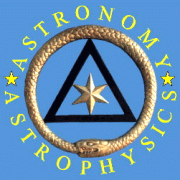
PhD Student
a.rodger.1@research.gla.ac.uk
Room 604
School of Physics and Astronomy
Kelvin Building
University of Glasgow
G12 8QQ
Scotland
Email:
Tel: +44 141 330 2960
Fax: +44 141 330 8600

PhD Student
a.rodger.1@research.gla.ac.uk
Room 604
School of Physics and Astronomy
Kelvin Building
University of Glasgow
G12 8QQ
Scotland
Email:
Tel: +44 141 330 2960
Fax: +44 141 330 8600
On the 7th October 2015, bright aurora/northern lights were visible over Glasgow due to fast solar wind from a coronal hole on the Sun. A&A group member Dr Iain Hannah was able to photograph this aurora (shown below) and a time lapse of it is available here.
On Friday 25th, four members of the group attended the Exploration 2015 at Glasgow Science Centre, a free night in which over 1000 members of the public came along to talk to researchers. We showed off some of the latest solar images and explained (using spectral lamps and spectrometers) why we look at the different colours/wavelengths of the solar light.
Amateur and professional astronomers are taking part in an observation campaign of solar flares until the 27th September 2015. F-HUNTERS is a campaign targeted to amateur astronomers, organized by the dissemination team of the F-CHROMA project. The main goal is to encourage solar astrophotographers to hunt for solar flares, along with space and ground-based solar observatories. The progress of the campaign can be followed on F-CHROMA’s Facebook page or Twitter feed.
F-CHROMA is a project funded by the European Union’s Seventh Framework Programme, coordinated by Prof Lyndsay Fletcher.
 In a short video, Alec explains the importance of solar system plasmas to be discussed at STFC Introductory Solar System Plasmas School hosted by Astronomy & Astrophysics group
In a short video, Alec explains the importance of solar system plasmas to be discussed at STFC Introductory Solar System Plasmas School hosted by Astronomy & Astrophysics group
The School’s objective is to bring internationally leading UK scientists to instruct and inspire the incoming PhD students. It will provide them with the broad context in which their specific research will reside, and encourage interdisciplinary thinking from the outset.

Thanks to Paul Wright and Duncan Stackhouse one can follow CESRA school via twitter #CESRA2015
Hamish Reid and Natasha Jeffrey speak about radio school in a short UoG video
BBC’s Sky at Night programme this month features work by Dr Iain Hannah on small explosive releases of energy in the Sun’s atmosphere observed by NASA’s NuSTAR telescope. These observations are trying to catch the faint X-ray signatures of electrons being accelerated which would give clues to the physics powering these events.

Glasgow University is hosting the 2015 CESRA radio summer school. The school is open to solar radio physicists including PhD students and early career researchers. The school will cover the essential elements of theory, modelling and data analysis and will feature lectures and tutorials. Students will have the opportunity to meet and discuss research topics with their peers together in an informal atmosphere.
Further details: http://www.astro.gla.ac.uk/cesra2015/
Baolin Tan (China), Alexey Kuznetsov (Irkutsk, Russia) and Sergei Kuznetsov and Alexander Morgachev (Pulkovo, Russia) visit our group to work on the solar flares and radio emission from the Sun. The visits are supported by pan-European EU funded network ‘RadioSun’ involving China, Czech Republic, Poland, Russia and the UK.
Dr Prasad Subramanian, an associate professor of Physics at IISER Pune, visited the Glasgow Astronomy Group to study eruptions on the Sun. The collaboration is associated with the renewal of an agreement between University of Glasgow and Indian Institute of Science Education and Research in Pune (IISER-Pune).
Duncan Stackhouse, Nic Bian, Iain Hannah and Eduard Kontar jointed solar flare experts from around the world gathered at NJIT last week to share the latest research with RHESSI at 14th RHESSI workshop.
Congratulations to Eduard Kontar and Nic Labrosse who have been newly elected to positions in the International Astronomical Union. Eduard has been elected to the Steering Committee of Division E (Sun and Heliosphere) and Nic to the Steering Committee of Commission E1 (Solar Radiation and Structure). Lyndsay Fletcher also takes over the Presidency of Commission E2 (Solar Activity) and remains as an ex officio member of Division E. All three group members formally assume their new roles after the closing ceremony of the XXIXth General Assembly of the IAU in Honolulu on 14th August 2015.
Work by A&A Group member Dr Iain Hannah has featured in a recent image/press release by the Royal Astronomical Society and NASA, showing an image of new X-ray observations of small flares (or microflares) taken with NASA’s NuSTAR telescope (blue in the image), combined with those in EUV from SDO/AIA (red/yellow) and lower energy X-rays from Hinode/XRT (green). This image recently featured as NASA’s image of the day.
Funded PhD studentship in Solar Physics at the University of Glasgow
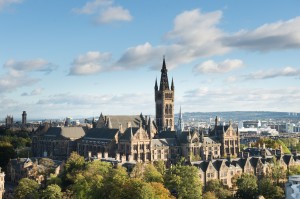 A fully funded PhD studentship for a UK/EU student is available at the University of Glasgow in solar flare physics. The project title is “Connections between solar flare characteristics and their underlying magnetic drivers” and will be using some of the latest solar data to investigate EUV/X-ray flare signatures relative to their magnetic properties derived from magnetograms. The primary supervisor will be Dr. Iain Hannah, the secondary Prof. Lyndsay Fletcher, within the Astronomy & Astrophysics group in the SUPA School of Physics and Astronomy at the University of Glasgow, UK.
A fully funded PhD studentship for a UK/EU student is available at the University of Glasgow in solar flare physics. The project title is “Connections between solar flare characteristics and their underlying magnetic drivers” and will be using some of the latest solar data to investigate EUV/X-ray flare signatures relative to their magnetic properties derived from magnetograms. The primary supervisor will be Dr. Iain Hannah, the secondary Prof. Lyndsay Fletcher, within the Astronomy & Astrophysics group in the SUPA School of Physics and Astronomy at the University of Glasgow, UK.
The PhD studentship will start between 1st August to 1st October 2015 for 3 years and has funding, from the University of Glasgow, for the fees (of a UK or EU student) and annual stipend (currently about £14,000).
Applicants should have (by the start date) at least a second class degree (or equivalent) in a relevant subject and ideally some experience of solar data analysis – coding in IDL, SolarSoft and/or Python.
Applications need to be made by Monday 15th June 2015 through the University of Glasgow’s postgraduate research opportunities page: http://www.gla.ac.uk/research/opportunities/howtoapplyforaresearchdegree/
Additional information on the application procedure is available on the School’s website: http://www.gla.ac.uk/schools/physics/research/postgraduate/
For more information please feel free to contact Dr Hannah at iain.hannah@glasgow.ac.uk
The University’s observatory at Acre Rd is being refurbished over the summer – below are some photos showing the current progress. The internal walls have been demolished since the last set of pictures of the obs refurb.
Duncan Stackhouse presented the best talk (about simulation of ‘kappa’ distribution and Numerical and Observational Examination of the Spectral Variation of Extended Coronal Hard X-Ray Sources of kappa-distribution) among 3rd year Ph.D. students of the school at the colloquium session (Wed May 6th, 2015).
Although the sky this morning had a Glasgow filter (i.e. the clouds) we were able to catch the progress of the moon throughout its journey across the face of the sun. At the very moment of maximum, the clouds thinned slightly, showing the eclipsed sun smiling down on us at the University of Glasgow. Thanks to all the staff and students that helped out and all the folk that came along and saw the eclipse.
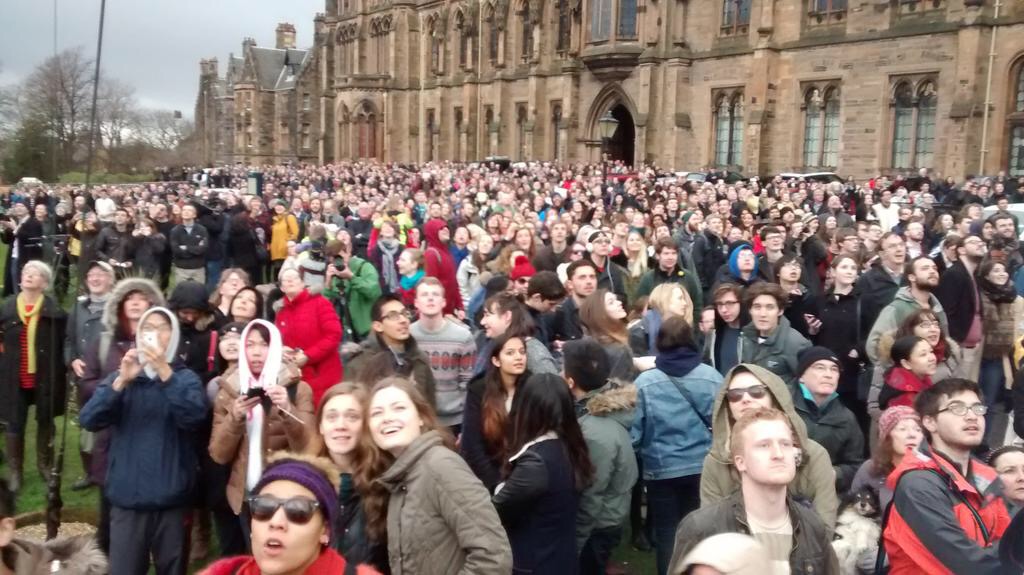
A large crowd gathered at the flagpole watching the clouded eclipse (thanks to @pjasimoes).

And the large crowd extends further along, watching the clouded eclipse at the University of Glasgow (thanks to @pjasimoes)
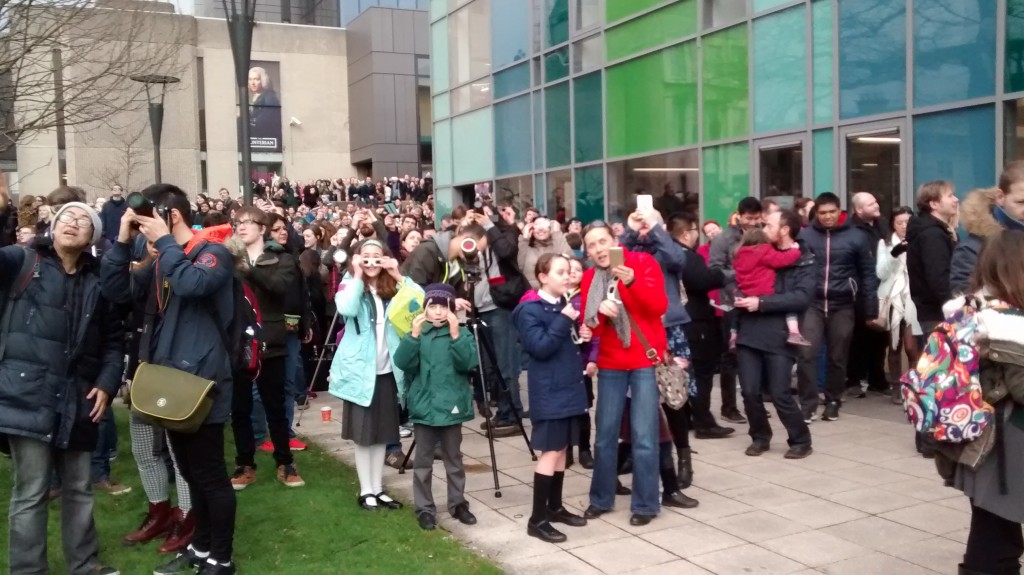
Eclipse viewers gathered at the Library and Fraser building waiting for the eclipse to peak (photo thanks to Laurence Datrier).
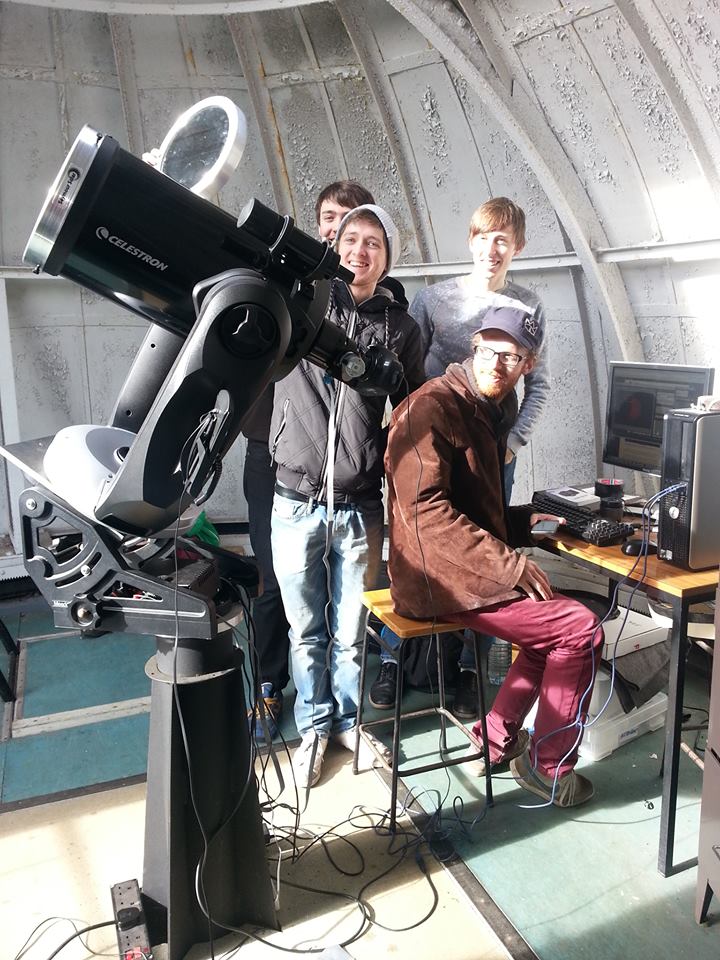
The students (Duncan Horne, Ruaridh Newman
Andrew Barr, William Newman) at the Acre Rd Observatory running the live feed
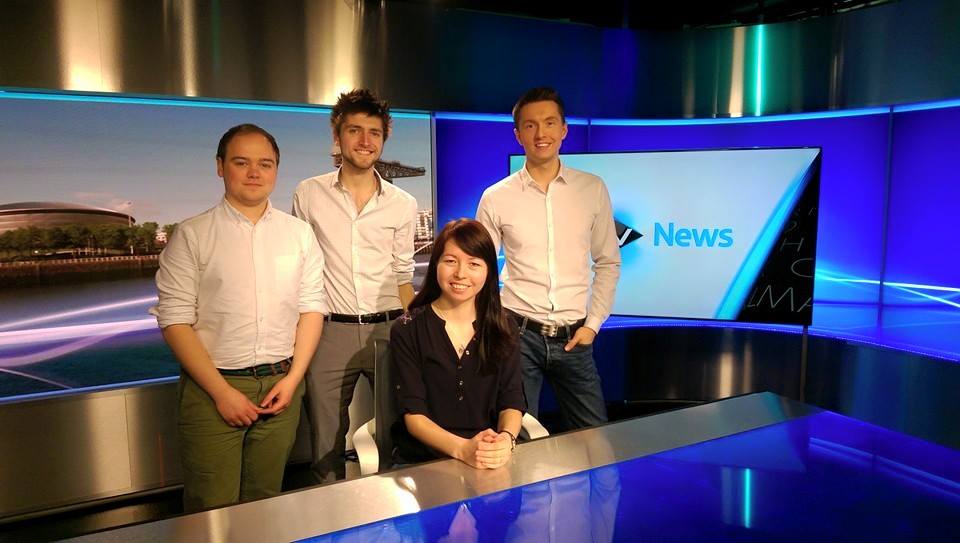
Some of the Glasgow solar PhD students (Paul Wright, Stephen Brown, Galina Motorina) broadcasting live with STV’s Sean Batty during the eclipse (photo thanks to Stephen Brown). You can rewatch the broadcast here.
The Sun from from the University of Glasgow Observatory – click for the live feed.
A rare partial solar eclipse will be viewable in Glasgow on Friday March 20th, with the maximum eclipse (the moon covering 94% of the Sun) occurring at 09:34am.
We have a live* feed at http://www.astro.gla.ac.uk/eclipse/live.html from University of Glasgow Observatory, updated every minute. There are also two viewing locations on the Main Campus University of Glasgow, where there will be telescopes and viewers to let you safely see the eclipse directly (weather permitting)
Thanks to the undergraduate solar project group, Peter Wakeford and Graham Kerr for setting this up and making the observations.
*The feed will be live and update during 8am to 11am Friday 20th March. Before then it will show a static test image taken with the same telescope & filter setup.